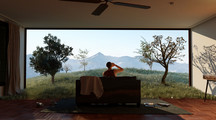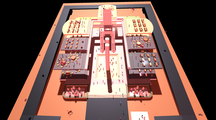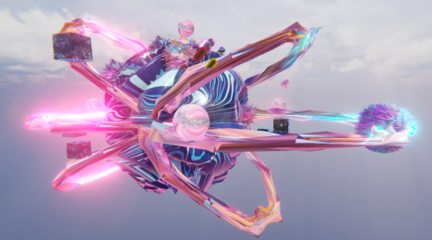
X-WORLDS
IDEAS Summer Studio
2020
“X for crossing, X for extended, X for exposed.”
This year’s IDEAS Summer Studio “X-WORLDS” marked the first entirely virtual introduction to the one-year Master of Science in Architecture and Urban Design (M.S.AUD) program at UCLA Architecture and Urban Design. The six-week program provided an immersion into the intersecting worlds of each of the four M.S.AUD research studios: Entertainment, Mobility, Technology and Urban Strategy. Each brings a unique world to the program, rich with their own techniques, tools, and industry connections. However, common to all the studios is a focus on technological innovation and future speculation, as we all search for the urgent agendas and new media at the edge of architectural practice.
This summer’s studio asked: what does it mean for architects to envision, design, build and visualize worlds? Four short, intensive modules served as primers for the research studios’ year-long briefs, with students exploring worldbuilding through the tools and lenses that each studio offers. The product: slices of four worlds that present windows into each of the studios’ research topics.
ALTER WORLDS (Entertainment)
Throughout history, architects have not only built environments to shelter us, but have worked through speculation to articulate fictional worlds that deliver the stories, values and aspirations of our time. More than ever before, especially as our cities have been transformed over recent months, and we live our lives confined within walls, there’s an urgency to speculate on the unknowable possible alternate futures that we may face.
As an exposure to the digital production pipelines employed by the entertainment and wider VFX industry, students created near future narratives illustrated through concept art. Beginning with a series of scenarios that alter our future, students imagined the consequences that could emerge, articulating these “what if futures” as “Alter Worlds.” Within this fiction, students individually proposed a single scenario; a tiny slice in time and space that captured the nature of their new reality, and produced a piece of concept art and logline – a premise for a future “Alter World”.
SIMULATED WORLDS (Mobility)
In an effort to shift our understanding of architecture from inert to mobile, this module exposes a series of questions: how can mobility generate new ways of understanding architecture? How can we design from vectors and understand today’s walls as obstacles? How can we use game engine platforms to simulate scenarios of complex mobility?
Students dived into the exciting world of simulation using artificial intelligence-based workflows on Unity. They learned how to move various mobility agents around different navigational regions. This module is the start of discussions around the urgency of thinking through circulation of people in buildings and its current critical flaws.
AUGMENTED WORLDS (Technology)
With the latest developments in game engines, procedural modeling and augmented reality (AR) technologies, architects and designers have the ability to generate and visualize the built environment in real-time in the physical and digital worlds. Added to a global pandemic and ongoing digitization of working and living spaces, these design technologies and modes of spatial representation become even more relevant. In this context we ask: how do we represent the user/human in these new environments and how do we invent new modes of interaction?
Students were introduced to conceptual ideas of new media, social media, interaction, digital vs. physical and the representation of the self in a techno-critical society. Using game engines and AR, they designed and visualized spatial worlds and avatars to investigate how these novel concepts and design technologies can be used in the field of architecture and spatial design.
MEDIA WORLDS (Urban Strategy)
LA is the most media centric city in the world. There are more photographs, videos, movies and books of LA than any other city. In some ways, fantasy has become more real than reality.
Films, videos and artworks about LA consistently depict both fantasy and tragedy – over the top aspirations of a great city and great life, coupled with widespread natural or social catastrophes.
Students explored the social media landscape of cities and created an urban imagery that proposes a positive collective future for LA2049. Students produced a single Instagram post speculating on the creation of a fire resilient urbanism for the most iconic of LA’s Hills: the Hollywood Hills. Through multiple scales, students interrogated the future lifestyles of the city: How do we move? What does the city and its architecture look like? How do we interact with each other?
Related Faculty |
Benjamin Ennemoser, Yara Feghali, David Jimenez Iniesta, Nathan Su |
Related topics |
Technology |














- ALTER WORLDS: Do Trees Dream While in Electric Sleep? by Maira Yasir
- ALTER WORLDS: Built-in Nature by Yejin Choi
- ALTER WORLDS: The Unfamiliar Gift by Chiayu Chen
- ALTER WORLDS: Flee by Tianzhi Xiao
- SIMULATED WORLDS: Multipurpose Entertainment Space by Mingyang Xu
- SIMULATED WORLDS: Architecture Department by Srujana Bhoopanam
- SIMULATED WORLDS: Cultural Park by Chhavi Goswami
- SIMULATED WORLDS: International Baroque Museum by Tianyang Xu
- AUGMENTED WORLDS: Students use AR to design and visualize avatars
- AUGMENTED WORLDS: Students use AR to design and visualize avatars
- AUGMENTED WORLDSS: Planet Torterra Garden by Srujana Bhoopanam
- AUGMENTED WORLDS: Planet Muyan by Muyan Duan
- MEDIA WORLDS: Speculations on the creation of a fire resilient urbanism for the Hollywood Hills
- MEDIA WORLDS: Speculations on the creation of a fire resilient urbanism for Hollywood Hills